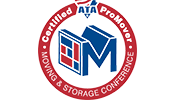MAKE YOUR MOVE ECO-FRIENDLY
1.Get creative with your packing materials!
Use items you will already be moving to pack – suitcases, plastic bins, baskets, dresser drawers, gym bags and duffel bags, etc. If you have an item that can fit other things inside it, fill it up before packing it. For example, line your bathroom trash bin with a fresh garbage bag and use it to store cleaning supplies or toiletries. The more you can fit in containers you already have, the more you can avoid having to rely on purchased moving boxes.
We, and most moving companies, offer used cardboard boxes at a discounted rate. Check with your moving company about this option, or ask local shops if they have any to spare. Wine boxes are especially sturdy and great for moving kitchen items or other heavy goods and many grocery stores will let you purchase or take their spare boxes. Store boxes you collect throughout the year from online shopping and other ventures. They can be folded flat and stored in the garage or under a bed out of sight until the time comes to use them.
Another way to get creative is with what you use to wrap items – you can use towels, linens, and even clothes to safely wrap up items for packing. If you need additional materials, start with newpaper, which you can throw in your standard recycling bin when finished. Any reduction in plastic materials is a step in the right direction!
2.Downsize!
It may seem an obvious solution but moving less stuff means a smaller carbon footprint – smaller truck, less packing materials, and as a bonus, lower cost. Take written inventory of what you own to avoid bringing unnecessary or duplicate items. Once you know what you’ll be getting rid of, find local donation centers. Furniture, in particular, gets thrown out at record-high levels – the EPA reports it makes up some 9.8 million tons of landfill waste. Instead, try donating these goods to charities like the National Furniture Bank Association, or the ones listed below. Many organizations will come right to your home to pick up larger donations!
You should only take to the landfill those items that truly cannot be repurposed or donated. You can donate unwanted items in good condition to a variety of charities, including Goodwill, Veterans for America, Value Village, Habitat for Humanity, and more. Find local organizations, as well – in Seattle, Northwest Center, Mary’s Place, and West Side Baby are always in need of donations. Animal shelters take a variety of donations as well, from standard pet supplies to old blankets.
3.Reuse, reuse, reuse!
Find ways to repurpose items you can’t donate. Moving inevitably involves cleaning. Cut tattered old clothes and linens you can’t donate into rags to clear up the dust and grime found along the way, or to use in place of kitchen towels once those are all packed up. Instead of paper towels, put these cloths to good use to cut down on waste.
4.Recycle!
When it comes to your recycle pile, be sure you’re getting rid of things the right way. Visit the EPA’s recycling site for more information.
i.Batteries: If you didn’t already know, batteries contain toxic substances like lead, sulfuric acid, and cadmium, which can leak into soil and nearby waterways. Take these to a local library or post office, which usually have a recycling center for batteries.
ii.Electronics: Old PCs don’t have to end up in the trash! Electronics and cords can be recycled at local resource recovery centers. You can also take them to Goodwill or Habitat for Humanity – these places often accept donations for these kinds of goods.
iii.Appliances: Old TVs, microwaves, and other appliances often contain lead and other harmful substances, so be sure to take it to a local Best Buy, where it will be recycled no matter where you bought it from.
iv.Paint Cans: Often, when you move, you’ll have excess paint from different parts of the house. Many resource recovery centers and hardware stores accept open cans of paint, stain, and varnish.
5.Eat up!
Instead of letting food go to waste or throwing away a freezer full when the time comes to move, start planning your meals around what you have in the kitchen. If you have non-perishable items you won’t eat before your move, donate them! Most moving charges take weight and volume into consideration, so this will cut down on costs – and on how much there will be to unpack in your new home. Move for Hunger is a 501c3 that helps distribute non-perishable food to local food banks. They have partnered with many moving companies, including North Coast/Allied International. Simply pack up a box of food, and let your moving crew pick it up on moving day and donate it for you.
6.Don’t pack up your kitchen right away!
The kitchen is one of the hardest rooms to pack, so it makes sense that many movers tackle it first. But once all of your dishes and flatware are stored away, you will be forced to rely on plastic plates, cups, and utensils to get by. As a better alternative, keep out just enough kitchen items to get you through the moving process so that you don’t get stuck using non-sustainable materials for your meals. If you own a camping kitchen set, leave that out instead – they tend to have everything you need, in a small package.
7.Stop the junk mail before it starts!
Make sure that only the mail you really want follows you to your new home. You can register with the Do Not Mail Registry to avoid countless mail marketers. For more information about this, visit the Ecocycle website.
Subscribe to North Coast Moving & Storage Co.'s Blog




